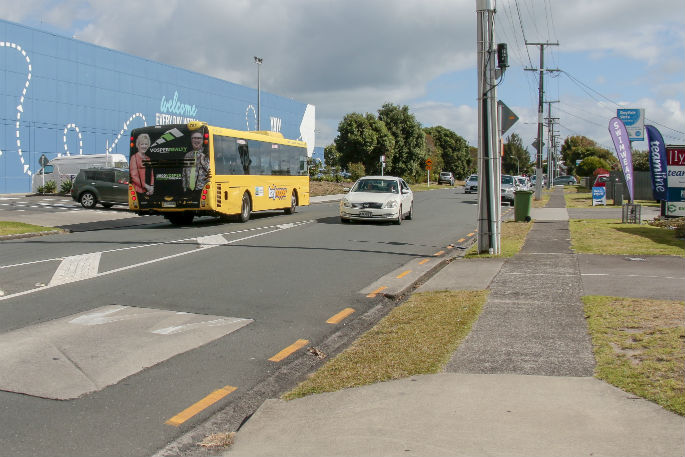Opposition to the Farm Street bus interchange is hardening up with residents saying they will be on hand to protest when work begins building the new Farm Street bus stops this morning.
Residents' spokesman Jon Jenner says they will hold city councillors responsible for any injuries or deaths resulting from what they say is an unsafe installation.
The interchange is having to be moved because of construction at the Mall itself.
The bus stop in use at the front entrance of the Bayfair shopping centre needs to be closed for Bayfair's expansion upgrade.
The council needs to give people a safe place to get on and off the bus when that happens, says ward councillor Steve Morris.
A temporary bus stop and two new pedestrian crossings will be built outside the Bayfair shopping centre on Farm Street.
The work will take about a month to complete and will involve some lane closures and traffic management.
Some roadside car parking spaces will be removed to make room for the bus stop and ensure it functions safely.
There will also be a smaller bus stop painted onto the road outside 55 and 57 Farm Street.
Jon says the council is going ahead with the Farm Street bus exchange in the face of contrary advice from two consultant reports; Aurecon and Abley.
The city council is also ignoring advice to reduce speed in Farm Street to 30km/h, says Jon, and it will not say why. Pedestrian crossings by the layby will not reduce the overall speed on Farm Street.
'There is no requirement in the Road Code to slow down for a pedestrian crossing if no one is on it or about to use it,” says Jon. 'How much will these two crossings 'calm' traffic speeds when no one is using them?”
A proposed alternative bus exchange at Baypark is not happening, because there are several issues, says Steve Morris.
- Most of the 80,000 people boarding buses at Bayfair in 2017 originated their bus trip at Bayfair. Only 16 per cent of the passenger numbers were transfers between bus services.
- Bayfair is the single largest destination in the Region for bus passengers apart from the Tauranga CBD, so any changes to operations in this area need to be carefully considered.
- Currently four services operate through Bayfair: Routes 30, 33, 36 and 2. These services arrive at Bayfair on a combination of roads including Grenada Street, Gloucester Street, Links Ave, and SH2 (Maunganui Road). The services directly Pāpāmoa – Bayfair –Mount Maunganui – Tauranga CBD – Windermere Campus – Tauranga Hospital.
- Given the strong demand for trips to and from Bayfair there will still need to be a number of services passing Bayfair to provide capacity during peak periods and access at off-peak periods.
- These would include Route 30, 33 and 2. With the change in interchange location some of these services could run more directly between Mount Maunganui/CBD and Bayfair utilising SH2 however most services would still operate similar to existing routes past Bayfair to provide coverage to local residents.”
- Moving services to Baypark to accommodate interchanges will add about $450,000 to annual operating costs.
The figure may be able to be reduced by about 20 per cent through more detailed planning and by reducing service coverage areas, says Steve.
'The cost is largely related to the limited permeability across SH2 and into the residential areas of Pāpāmoa which require services to make large detours prior and after accessing Baypark,” says Steve.
'These detours compound costs due to high levels of congestion and construction works in the vicinity of Baypark.
And the regional council has changed bus providers, putting it in a poor bargaining position with the current operator Go Bus. At least four more buses would be required and it's considered unlikely Go Bus will invest in them.
Also, diverting services to Baypark will add about 10 minutes to most bus trips, except for passengers on Route 36 (Maungatapu, Bayfair and Papamoa) who would see a six minute time saving.
The overall impact of the increase travel time will reduce patronage which will compound congestion issue already being experienced in the area.
'The need for many passengers to transfer between services at Baypark, as opposed to traveling directly to Bayfair will add both inconvenience and time to their trip,” says Steve.
Even a well-co-ordinated transfer between services typically adds five minutes to journey times.
'The current network is not well coordinated or reliable, meaning that connections will take much longer than five minutes and there is a high probability that even well planned connections will be missed due to delays caused by congestion,” says Steve.
On weekends, when services are much less frequent, passengers who miss a connection could be stranded for up to an hour while waiting a service to Bayfair.
Baypark also has safety issues in its present form, being poorly lit and a long way from other residences or businesses.



0 comments
Leave a Comment
You must be logged in to make a comment.